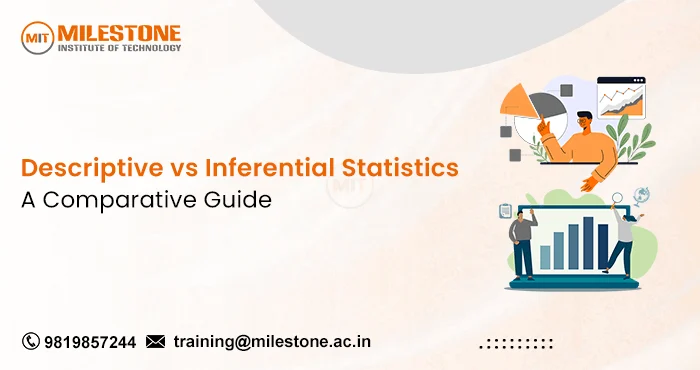Statistics is fundamental to data analysis, offering a framework for making sense of information and deriving valuable insights. Within this expansive discipline, two primary branches are crucial: descriptive and inferential statistics. Although each serves a unique role and uses different methods, together they form a robust toolkit for understanding and interpreting data. In this guide, we’ll delve into the differences between
descriptive vs inferential statistics, explore their respective applications, and clarify the key concepts that distinguish them. Understanding the difference between descriptive and inferential statistics will enhance your ability to analyze and utilize data effectively.
What is Descriptive Statistics?
Descriptive statistics focuses on summarizing and describing the features of a dataset. It offers basic outlines of the sample and the measurements. These summaries can either be a part of the visual data (graphs, charts, tables) or numerical data (mean, median, mode, standard deviation, etc.).
Key Concepts in Descriptive Statistics
- Measures of Central Tendency: Among them are the mean (average), median (middle value), and mode (most often occurring value). These measures give us an idea of the central point of the data.
- Measures of Dispersion: These include range (difference between the highest and lowest values), variance (average squared deviation from the mean), and standard deviation (square root of the variance). These measures describe the spread or variability in the data.
- Frequency Distribution: This refers to the arrangement of data values and their frequencies. It can be presented in the form of tables, histograms, or pie charts.
- Percentiles and Quartiles: Percentiles show the value less than the specified percentage of observations. Quartiles split the data in four equal sections.
Uses of Descriptive Statistics
Descriptive statistics are used to:
- Large datasets should be summarized in order to make it more understable.
- Identify patterns and trends in data.
- Provide insights through visualizations and summary statistics.
- Serve as a preliminary step before conducting inferential analysis.
What is Inferential Statistics?
Inferential statistics goes beyond simply describing the data. It means determining conclusions and projections about a population from a data sample. It makes estimating population parameters and testing hypotheses easier.
Key Concepts in Inferential Statistics
- Population vs. Sample: A sample is a subset of the population; a population is all members of a specified group. Inferential statistics uses samples to make generalizations about the population.
- Hypothesis Testing: This involves testing an assumption (hypothesis) about a population parameter. Commonly used statistical tests include analysis of variance (ANOVA), chi-square tests, and t-tests.
- Confidence Intervals: These provide a range of values, derived from a sample, that is likely to contain the population parameter. It gives an estimate of the uncertainty around the sample statistic.
- p-Value: The p-value indicates the probability of obtaining results at least as extreme as the observed data, assuming the null hypothesis is true. If the p-value is low, the null hypothesis may be rejected, which shows that this is a possibility.
- Regression Analysis: This method estimates the relationship between variables. One may forecast values of one variable depending on another using it.
Uses of Inferential Statistics
Inferential statistics are used to:
- Translate sample findings to a wider population.
- Test hypotheses and draw conclusions.
- Make predictions and forecast future trends.
- Determine relationships between variables.
Descriptive vs Inferential Statistics : Key Differences
Purpose
- Descriptive Statistics: Summarizes and outlines a dataset’s characteristics.
- Inferential Statistics: Makes predictions and inferences about a population based on a sample.
Data Analysis Focus
- Descriptive Statistics: Focuses on the data itself, providing summaries and visualizations.
- Inferential Statistics: Focuses on making inferences and drawing conclusions from the data.
Techniques Used
- Descriptive Statistics: Mean, median, mode, range, standard deviation, frequency distributions.
- Inferential Statistics: Hypothesis testing, confidence intervals, regression analysis, p-values.
Scope
- Descriptive Statistics: Limited to the data at hand, providing insights without making generalizations.
- Inferential Statistics: Extends beyond the data at hand to make predictions or generalizations about a larger population.
Examples of Descriptive and Inferential Statistics
Descriptive Statistics Example
Consider a company that wants to understand the average age of its employees. By collecting the ages of all employees and calculating the mean, median, and mode, the company can get a clear picture of the age distribution. Additionally, it can use standard deviation to understand the variation in ages.
Inferential Statistics Example
Using a patient sample, a pharmaceutical corporation does a clinical experiment on a new drug. Inferential statistics allows the company to infer the drug’s effectiveness for the entire population based on the sample results. By conducting hypothesis testing and calculating confidence intervals, the company can determine if the drug is significantly effective.
The Interplay Between Descriptive and Inferential Statistics
While descriptive and inferential statistics serve different purposes, they often work together in
data analysis. Descriptive statistics provide the necessary foundation, helping analysts understand the data’s basic features before moving on to inferential analysis. Without descriptive statistics, the data’s patterns and trends might remain hidden, making it challenging to draw accurate conclusions from inferential statistics.
Frequently Asked Questions
What are the main differences between inferential statistics vs descriptive statistics?
Descriptive statistics summarize and describe the features of a dataset, focusing on central tendencies, dispersion, and frequency distributions. Inferential statistics, on the other hand, use sample data to make predictions and inferences about a larger population, often involving hypothesis testing, confidence intervals, and regression analysis.
Can descriptive and inferential statistics be used together?
Yes, descriptive and inferential statistics are often used together in data analysis. Descriptive statistics provide a summary and visualization of the data, helping to identify patterns and trends. Inferential statistics build on this foundation to make predictions and draw conclusions about a larger population.
How do descriptive and inferential statistics complement each other in data analysis?
Descriptive and inferential statistics complement each other by providing a comprehensive approach to data analysis. Descriptive statistics help in summarizing and visualizing the data, making it easier to understand its basic features and identify any patterns or anomalies. Inferential statistics then use this summarized data to make predictions, test hypotheses, and draw broader conclusions about a population, allowing researchers to extend their findings beyond the immediate dataset.




